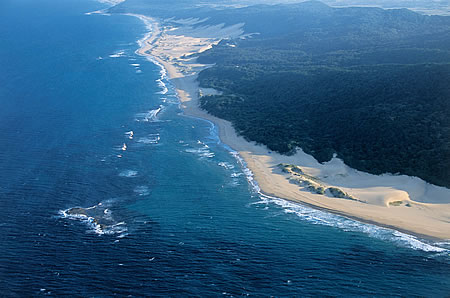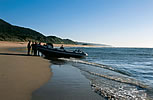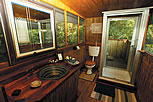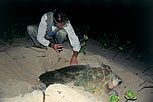![]()
The Wild Coast South Africa

Vacationtechnician personalized luxury adventure travel transports you to the most exquisite wilderness and chill out retreats on Earth. Conserving rare biodiversity through low volume tourism; our aim is your indulgence -at no one's expense. Plan now to be assured a rejuvenating escape at a restful pace -to an unspoilt gem in the purest sense.
For years the Wild Coast - the coastline between the Kei River in the south and the Umtamvuna River in the north, in the former Transkei - was one of South Africa's least known and travelled areas. But now the prospect of tourism reviving an impoverished Eastern Cape economy is causing this, and the very nature of the region, to change.
The Wild Coast is a delightful coastline of contrasts, with a diversity of plants and animals unequalled anywhere in the world. This breathtakingly beautiful stretch offers small beaches fringed by coastal rivers and crystal-clear lagoons, towering cliffs from whose heights waterfalls plunge into the ocean below, rolling hills, dense indigenous forests, and deep gorges in the depths of which one glimpses secret streams, and where one can sometimes hear the cough of a hunting leopard.
The Wild Coast consists of more than coastal geographical features, however: there's yet another boundary that serves to define this remarkable area, and assist in its creation and preservation, and that's the Agulhas Current. Flowing southwards, this vast volume of water follows the continental shelf at rates of sometimes as fast as four knots, the speed at which a person walks. On calm days this is a well-defined mirror of indigo blue, acting as the offshore boundary to the coastal waters.
Along the KwaZulu-Natal (to the north) and Border (to the south) areas, the continental shelf tends to be found some 35 kilometres offshore, but in the area between the Msikaba River and Coffee Bay, this distance decreases until, off Port St Johns, it's only 10 kilometres out.
The waters inshore of this great current are where one of Africa's largest yet least-known migrations occurs. Every year, coinciding with the first gales of winter, huge shoals of sardines head northwards up the coast, accompanied by schools of predatory gamefish and sharks foraging on them from below, and thousands of dolphins preying in the upper levels. Over all of this a wheeling, soaring mass of delta-winged gannets plummet repeatedly into the depths, gorging themselves into a stupor.
Depending on seasonal moods, these Indian Ocean waters can thunder ashore, crashing onto headlands of stark rock, throwing vast plumes high into the air and sucking the sand off the beaches, leaving them changed. The very next tide, however, may be different, as gentle seas repair the damage done.
When the great gales of winter start, the heavy seas and freak wave phenomena for which the area is renowned and feared manifest themselves. South-westerly winds howl across the ocean, impeding the flow of surface waters and generating swells that travel against the current, sometimes overtaking one another and creating gigantic waves that have been measured at heights of more than 54 metres.
This is, in places, a rugged coastline of rocky headlands and reefs stretching to the water's edge, where sailors both ancient and modern have lost their vessels and, often, their lives. The list of ships wrecked and lost in these waters is a long one indeed: the passenger liner the Waratah, which disappeared without trace, and whose loss remains one of the world's unsolved maritime mysteries, the Sao Bento, the Grosvenor, the Melliskerk, the Nylstream Meadow, the Horizon, the Cordigillo... The list goes on, a grim drumroll of lives and vessels lost. Even today, shipwrecks occur with regularity along the Wild Coast.
It was these seas and storms that first changed the character of the region, as survivors reaching Delagoa Bay or the infant city of Cape Town brought with them tales that encouraged explorers to return in search of treasure, such as that of the Grosvenor, or to hunt elephant and the other game that abounded in the area.
The Wild Coast is home to the Xhosa and Pondo peoples, who for centuries have inhabited the rolling green hills of the coastal terrace that rises from the shoreline. The earliest records of their presence are the reports of shipwrecked mariners from the Sao Joao, which foundered near Port St Johns in June 1552. Many of the shipwreck survivors spent years living among these tribes, learning their language and gaining understanding of their customs. They reported that travellers were well looked after, as (unlike the Dutch and English) the Xhosa never dealt in slaves. Visitors to the area moved about freely, without fear - providing they did not carry with them iron or copper goods, as these were highly sought-after, and reason enough to rob or even kill for.
Every village had a special hut where visitors were housed, fed and entertained. Many of the survivors, wearied, succumbed to this hospitality and elected to remain, finally becoming absorbed into the tribes. An example of this is the Abelungu, or Ama'Bessie, a tribe descended from a young white girl, the sole survivor of a ship wrecked on this shore in the early 18th century.
This warm hospitality still exists today and can be found in the remoter areas of the region, where any person observing the dignity and dictates of good manners will be met with a warm welcome.
Shipwreck survivors also reported that the coast was very fertile and densely populated. Crops such as sorghum, beans and pumpkins were grown, with the numerous herds of cattle roaming the hills forming the basis of the tribal economies. Chiefs ruled the tribes, regulating and controlling their day-to-day existence and acting as the head of the legal system. The tribal lifestyle was well integrated into the ecology of the area, and resulted in the country remaining largely unspoiled. Political and geographical constraints prevented any major coastal development, and to this day Port St Johns is the only town along the coast.
White families residing in the early Transkei were granted leases to small plots of ground at designated areas, normally river mouths. There they built low-cost fishing and holiday shacks. Site occupation was limited to these families, and thus became treasured. If the families died out or left, the sites were passed down to the closest relatives or friends.
The Wild Coast, especially north of Port St Johns, has always been recognised as a hotspot of botanical diversity and a zone of endemism, with a still-unknown number of endemic plants, shrubs, trees and grasses. The Pondoland Endemic Centre contains at least 130 endemic plants, compromising about 100 species of sub-shrubs and herbs, and more than 30 woody species. Best known of these is the rare and highly localised Pondoland coconut palm, which grows only on the northern banks of the Msikaba and Mtentu rivers, and which has been declared a national monument.
Also found on the Wild Coast are the last surviving specimens of a small bush that botanists call Raspalia trigyna. There is the possibility that other specimens exist, but for the moment, these three unprepossessing shrubs are all that are left of a special part of evolution.
A number of reserves exist, serving to protect the flora and fauna. These are Hluleka, Silaka, Cwebe and Mkambati and, situated at the mouth of the Bashee River, Dwesa, which was opened in September 1976, becoming the first reserve to be declared by any of the then 'independent homelands'.
When Transkei became an 'independent state' in 1974, it entered two decades of politically created isolation that inadvertently assisted in protecting this unspoiled coastline. In 1994, when the Wild Coast once again became more accessible to the out-side world, its stunning beauty and low-scale land utilisation brought the area to the most important crossroad in its existence.
Recognising the scenic and ecological uniqueness of the region, the current government is initiating steps to enhance and preserve the area for the benefit of future generations. Aware, too, that no sustainable development can be undertaken without determining the needs and aspirations of communities settled in the area, studies are being undertaken in consultation with these commu-nities to determine how best to initiate long-term sustainable development. Guidelines are now being formulated and implemented.
The Cwebe and Dwesa reserves, subjects of long-term land-claim issues, have
been handed back to resident local communities, being leased on a 99-year
basis, provided that they remain conservation areas in perpetuity. In addition
to rentals received, tribespeople are to be involved in reserve developments.
The process is a protracted one, as steps and actions initiated now hold major
implications for the future.
Plans are in place for the creation of the Pondoland Park. This 50 000-hectare
coastal bio-reserve is planned to stretch some 80 kilometres, from the northern
bank of the Umzimvubu River to the southern bank of the Umtamvuma River, with
the present Mkambati Reserve forming the development core. This will effectively
preserve a major section of the least-spoilt and least-developed section of
the Wild Coast and should attract international ecotourism.
If the positive aspects of this are realised, the park could possibly be extended
to as far as the Kei River in the south.
The Mkambati Reserve itself is to be increased from its present 8 000 hectares to 12 500 hectares, and there is talk of introducing white rhino and buffalo into the area. In addition, there are plans for the development and marketing of the reserve as a multi-faceted project aimed at all sectors of the tourist trade, with emphasis on the overseas market.
The European Union has earmarked R80-million for the development of community-driven tourism-based projects along the Wild Coast. What is being looked at is the type of development based on what communities can provide as an extension of their daily lifestyles and which, as such, will be sustainable. Projects are coming into being, some good, some strangely out of line with the reality of the Wild Coast, but all of them, for better or worse, bringing about massive changes in the area.
The government-funded Wild Coast Spatial Development Initiative (SDI) is perceived as being far too slow in its delivery of tourist-based economic opportunities. Developments favoured to date are capital-intensive projects totally unsuited to the area, such as the R200-million five-star Mauritius-style resort hotel and development planned for The Haven.
There is also a threat that the N2 will be diverted to a route closer to the coastline. The proposed new route, costing the taxpayer millions, will save a nominal 90-odd kilometres on the journey between Durban and East London. Conservationists are highly concerned about the impact the road will have on the area.
Even more perturbing are the changes being wrought as a result of socio-economic demands, coupled with a breakdown of and disregard for laws designed to protect the ecology. Slash-and-burn intrusion into previously protected areas is resulting in the destruction of tracts of indigenous forests. This opens the way for colonisation by alien invader plant species. Vast areas of land previously covered by dense forest are now host to Karoo-type acacia species, or else have become open grasslands covered by the stubble of poor-quality grass.
The substitution of lighter-coloured vegetation for dark coastal forests is provoking climatic changes as well. Heavy, dark forest canopies generate thermals, which rise to meet the prevailing rain-bearing south-westerly winds and thus ensure that rainfall is both timeous and generous. Rainfall patterns are now rapidly changing. In addition, run-offs, once easily constrained by dense undergrowth, now scour topsoil from sheer slopes, carrying this into rivers that are becoming choked and silted, in turn contributing to the destruction of estuarine systems.
The previously untapped natural resources of the Wild Coast are proving an easy source of supply for unscrupulous dealers seeking to make a quick fortune with little or no concern for the future. Uncontrolled access by environmentally insensitive 4x4s has resulted in tracks being opened into previously unreachable areas, making access by poachers much easier, either to get at the seafood for which they have created a market among the locals, or to hunt the game-filled forests.
Promises of local employment and building schools have been the most common methods used to obtain permission from local chiefs to occupy and build, and illegal developments such as houses and cottages have been erected in some of the most pristine spots in demarcated protected areas. These illegal cottage owners have justified their intrusion into these areas under the pretext of community upliftment, but not one of them has ever explained to the chiefs and local inhabitants the actual intrinsic worth of the property so immorally acquired.
Conservation in the area is being driven by an understaffed and under-funded Department of Environmental Affairs and Tourism. An equally understaffed Department of Water Affairs and Forestry, as well as Marine and Coastal Management officials, are finding themselves hard pressed to police and control this vast territory.
The Wild Coast, with its reputation for being wild, rugged and inhospitable, is now also vulnerable and defenceless. Unless action is taken to protect and preserve it, its very special character will disappear, along with the Raspalia trigyna.
South Africa Reading
South Africa's Biotic
Wealth
South Africa:
Kruger National Park
Garden Route Activities
The Garden Route
Wild Frontier -Eastern Cape
The Wild Coast
Namaqualand
Namaqualand and more
Greater Addo National Park
Ndumo Game Reserve
HLUHLUWE-UMFOLOZI PARK
The Lowveld –Birding
ADDO ELEPHANTS
Drakensburg UNESCO World
Heritage Site
---------------------------------------------------
Listening • Understanding •Planning
Introduce Yourself -
Scheduled Trips - Private Safaris
- Newsletter
About Us - Our Mission
- Our Philosophy - Yacht
Charter - DryGoods
![]() We speak English
We speak English
![]() Wir sprechen Deutsch
Wir sprechen Deutsch
![]() On parle français
On parle français
![]() Parliamo italiano
Parliamo italiano
info at vacationtechnician dot com
Thanks for visiting vacationtechnician.com
Friendly•Dependable•Knowledgeable•Experienced
© 1998-2007 vacationtechnician.com All Rights Reserved




